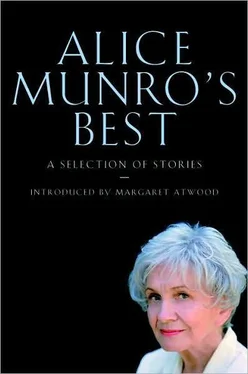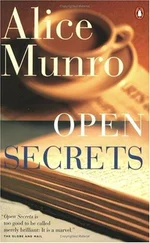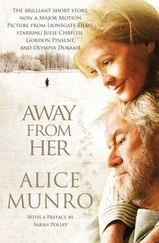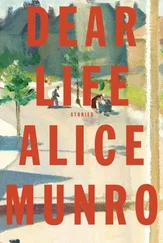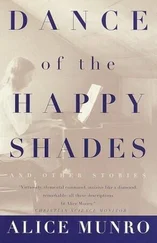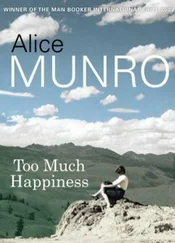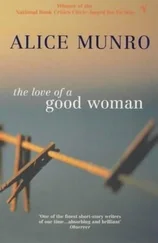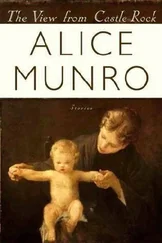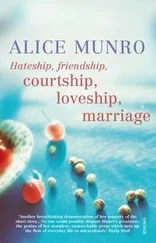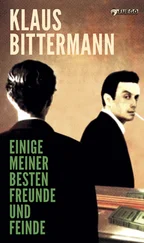Through Munro’s fiction, Sowesto’s Huron County has joined Faulkner’s Yoknapatawpha County as a slice of land made legendary by the excellence of the writer who has celebrated it, though in both cases “celebrated” is not quite the right word. “Anatomized” might be closer to what goes on in the work of Munro, though even that term is too clinical. What should we call the combination of obsessive scrutiny, arche-ological unearthing, precise and detailed recollection, the wallowing in the seamier and meaner and more vengeful undersides of human nature, the telling of erotic secrets, the nostalgia for vanished miseries, and rejoicing in the fullness and variety of life, stirred all together?
At the end of Munro’s Lives of Girls and Women (1971), her only novel and a bildungsroman —a novel of development, in this case a portrait of the artist as a young girl—there’s a telling passage. Del Jordan of Jubilee, who has by now—true to her last name—crossed over into the promised land of womanhood and also of writerhood, says of her adolescence:
It did not occur to me then that one day I would be so greedy for Jubilee. Voracious and misguided as Uncle Craig out at Jenkin’s Bend, writing his history, I would want to write things down.
I would try to make lists. A list of all the stores and businesses going up and down the main street and who owned them, a list of family names, names on the tombstones in the cemetery and any inscriptions underneath…
The hope of accuracy we bring to such tasks is crazy, heartbreaking.
And no list could hold what I wanted, for what I wanted was every last thing, every layer of speech and thought, stroke of light on bark or walls, every smell, pothole, pain, crack, delusion, held still and held together—radiant, everlasting.
As a programme for a life’s work this is daunting. Nevertheless it’s a programme Alice Munro was to follow over the next thirty-five years with remarkable fidelity.
*
Alice Munro was born Alice Laidlaw, in 1931, which means that she was a small child during the Depression. She was eight in 1939, the year Canada entered the Second World War, and she attended university—the University of Western Ontario, in London—in the postwar years. She was twenty-five and a young mother when Elvis Presley first became famous, and thirty-eight at the time of the flower-child revolution and the advent of the women’s movement in 1968–9, a moment in time that saw the publication of her first book. In 1981 she was fifty. Her stories are set mainly over these years—the ′30s to the ′80s—or even before then, in the time of ancestral memory.
Her own ancestry was partly Scotch Presbyterian: she can trace her family back to James Hogg, the Ettrick Shepherd, friend of Robert Burns and the Edinburgh literati of the late eighteenth century, and author of The Confessions of a Justified Sinner , which could itself be a Munro title. On the other side of the family there were Anglicans, for whom the worst sin is said to consist of using the wrong fork at dinner. Munro’s acute consciousness of social class, and of the minutiae and sneers separating one level from the next, is honestly come by, as is—from the Presbyterians—her characters’ habit of rigorously examining their own deeds, emotions, motives, and consciences, and finding them wanting. In a traditional Protestant culture, such as that of small-town Sowesto, forgiveness is not easily come by, punishments are frequent and harsh, potential humiliation and shame lurk around every corner, and nobody gets away with much.
But this tradition also contains the doctrine of justification by faith alone: grace descends upon us without any action on our part. In Munro’s work, grace abounds, but it is strangely disguised: nothing can be predicted. Emotions erupt. Preconceptions crumble. Surprises proliferate. Astonishments leap out. Malicious acts can have positive consequences. Salvation arrives when least expected, and in peculiar forms.
But as soon as you make such a pronouncement about Munro’s writing—or any other such analysis, inference, or generalization about it—you’re aware of that mocking commentator so often present in a Munro story—the one who says, in essence, Who do you think you are? What gives you the right to think you know anything about me, or about anyone else for that matter? Or, to quote from Lives of Girls and Women again, “People’s lives… were dull, simple, amazing and unfathomable—deep caves paved with kitchen linoleum.” The key word here is “unfathomable.”
*
The first two stories in this selection, “Royal Beatings” and “The Beggar Maid,” are from a book with two different titles. In Canada it was called—after a term of peevish accusation used to let the air out of somebody else’s puffed-up head— Who Do You Think You Are? In the United States and England it was called, romantically, The Beggar Maid. The stories in this enigmatically-titled book have a common protagonist—Rose, who grows up in a poorer section of a town called Hanratty with her father and her stepmother Flo, then goes to university on scholarship, marries a man from a social level far above hers and later runs away from him, and then, later still, becomes an actress—a cardinal sin and cause for shame in the Hanratty still inhabited by Flo. Who Do You Think You Are? is thus another bildungsroman —an account of the formation of its heroine—and another portrait of the artist.
What is fakery, what is authenticity? Which emotions and modes of behaviour and speech are honest and true, which pretended or pretentious? Or can they be separated? Munro’s characters think frequently about such matters.
As in art, so in life. Hanratty society is divided in two by the river that flows through the town:
In Hanratty the social structure ran from doctors and dentists and lawyers down to foundry workers and factory workers and draymen; in West Hanratty it ran from factory workers and foundry workers down to large improvident families of casual bootleggers and prostitutes and unsuccessful thieves.
Each half of the town claims jeering rights against the other. Flo goes across to Hanratty, the better part of town, to shop, but also
to see people, and listen to them. Among the people she listened to were Mrs. Lawyer Davies, Mrs. Anglican Rector Henley-Smith, and Mrs. Horse-Doctor McKay. She came home and imitated their flibberty voices. Monsters, she made them seem, of foolishness, and showiness, and self-approbation.
But when Rose goes to college and boards with a lady professor and becomes engaged to Patrick, son of a West Coast department-store tycoon, and gets a look at upper middle-class surroundings, Flo in turn becomes monstrous in Rose’s eyes, and Rose is divided against herself. Patrick’s visit to Rose’s home town is a disaster for Rose:
She felt ashamed on more levels than she could count. She was ashamed of the food and the swan and the plastic tablecloth; ashamed for Patrick, the gloomy snob, who made a startled grimace when Flo passed him the toothpick-holder; ashamed for Flo with her timidity and hypocrisy and pretensions; most of all ashamed of herself. She didn’t even have any way that she could talk, and sound natural.
Yet as soon as Patrick begins to criticize her town and family, Rose feels “a layer of loyalty and protectiveness… hardening around every memory she had…”
This state of divided allegiance applies to Munro’s vocation as well as to considerations of social status. Her fictional world is peopled with secondary characters who despise art and artifice, and any kind of pretentiousness or showing off. It’s against these attitudes and the self-mistrust they inspire that her central characters must struggle in order to free themselves enough to create anything at all.
Читать дальше
